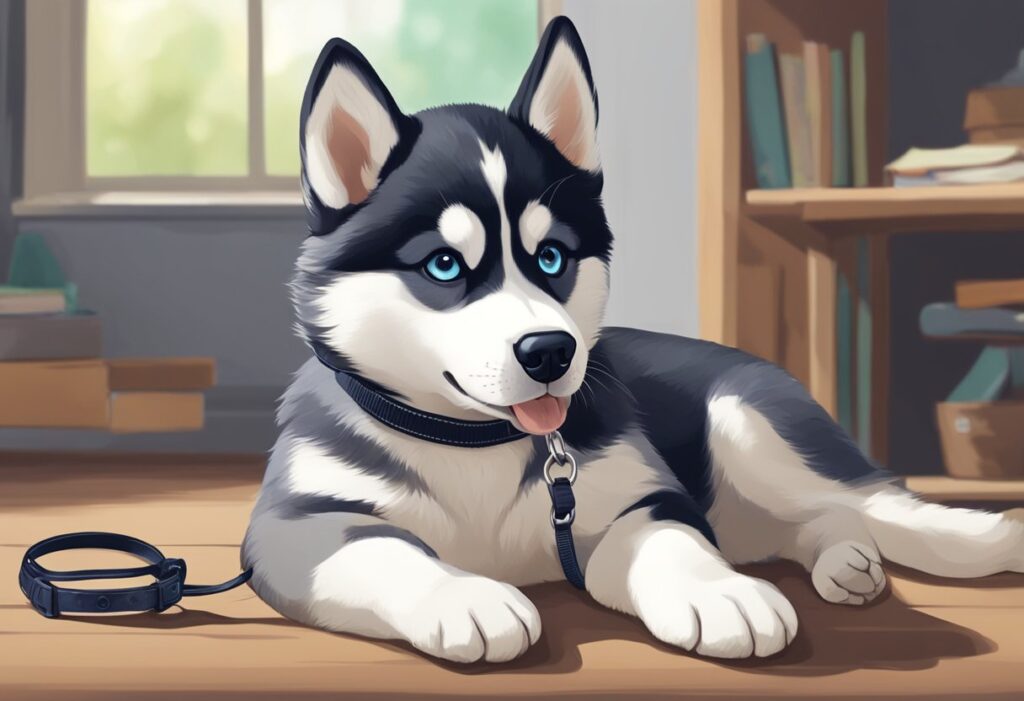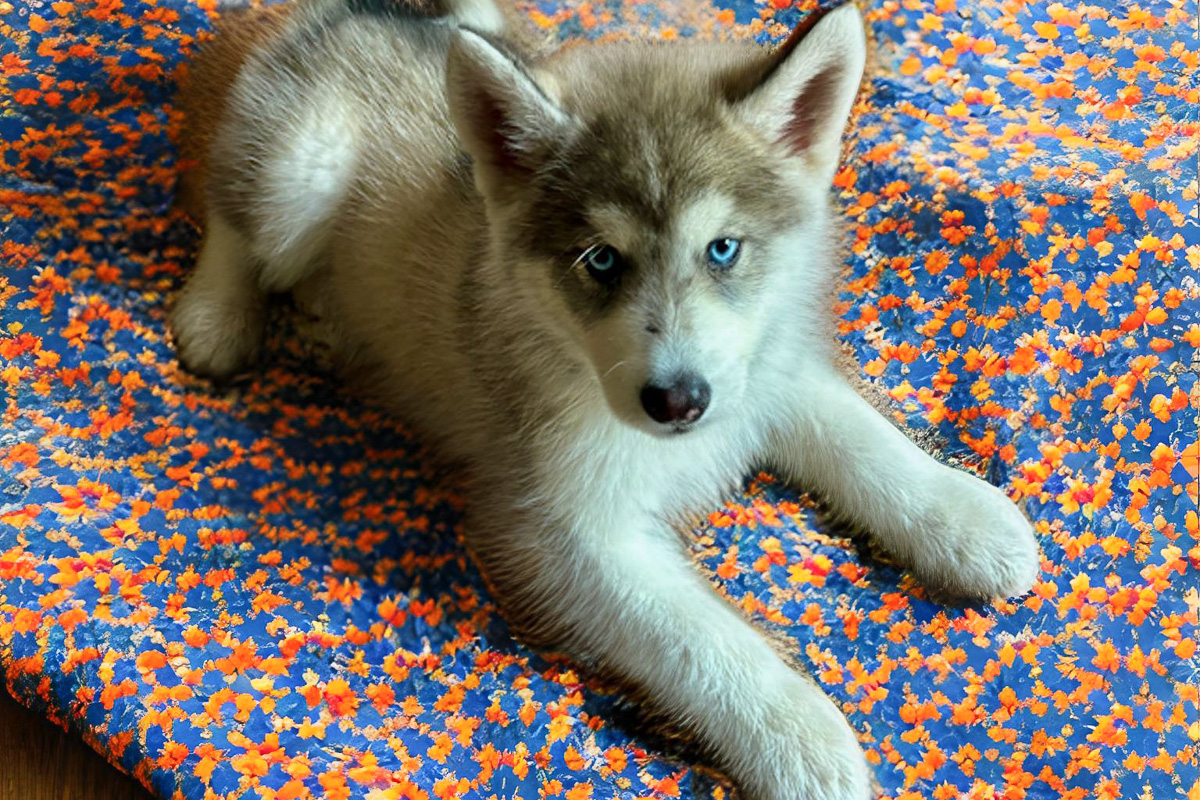Husky puppies are known for their striking looks and playful personalities. They can also be a handful to train due to their independent nature. Starting early and using consistent, positive methods are key to successfully training a husky puppy.

Huskies need plenty of mental and physical exercise to stay happy and well-behaved. Short, fun training sessions work best for these energetic pups. Using treats and praise helps keep them motivated to learn.
Basic obedience commands like sit, stay, and come are important first steps. Crate training can also be helpful for housebreaking and giving your husky a safe space. Socializing your puppy with different people, animals, and situations is crucial for raising a well-adjusted adult dog.
Key Takeaways
- Start training early with short, positive sessions
- Focus on basic obedience and crate training
- Provide lots of exercise and socialization opportunities
Understanding Husky Puppy Behavior
Siberian huskies are known for their unique personality traits. As puppies, they display high energy levels and a curious nature.
Husky puppies can be stubborn at times. This trait comes from their history as working dogs bred to make independent decisions in harsh conditions.
Their attention spans are often short. Training sessions should be kept brief and fun to keep them engaged.
Huskies have a strong pack mentality. They thrive on social interaction with both humans and other dogs.
Key behaviors to watch for:
- Playfulness
- Desire to explore
- Tendency to chew on objects
- Occasional stubbornness
Early socialization is crucial for husky puppies. Exposing them to different people, animals, and environments helps shape well-rounded adult dogs.
Huskies are intelligent and pick up commands quickly. However, they may choose when to obey based on their own motivations.
Exercise is vital for husky puppies. Without enough physical activity, they may become destructive or develop behavioral issues.
Patience is key when training husky puppies. Consistent, positive reinforcement works best with this breed.
Essentials of Husky Puppy Training
Husky puppies need proper training from an early age. These smart and energetic dogs respond best to positive reinforcement methods.
Start with basic obedience commands like sit, stay, and come. Use treats and praise to reward good behavior. Keep training sessions short and fun to match a puppy’s attention span.
Consistency is key when training a husky puppy. All family members should use the same commands and rules. This helps the puppy learn faster and avoid confusion.
Huskies are known for their strong-willed nature. Patient and firm training will help establish good habits. Never use harsh punishments, as this can damage the bond with your puppy.
Socialization is crucial for husky puppies. Expose them to different people, animals, and environments. This builds confidence and prevents fear or aggression later in life.
Exercise is important for husky puppies. Regular walks and playtime help burn energy and make training easier. A tired puppy is often more willing to learn and listen.
Crate training can be helpful for huskies. It gives them a safe space and aids in house training. Make the crate a positive place with treats and toys.
Mastering Basic Commands and Crate Training
Teaching basic commands and crate training are key parts of raising a well-behaved husky puppy. These skills help build a strong bond and make life easier for both the puppy and owner.
Command Training Basics
Start with simple commands like “sit,” “down,” and “stay.” Use treats to reward good behavior. Keep training sessions short, about 5-10 minutes each. Repeat sessions a few times daily.
For “sit,” hold a treat near the puppy’s nose. Slowly move it up and back. As the puppy’s head tilts up, its bottom will lower. Say “sit” and give the treat when the puppy sits.
For “down,” start with the puppy sitting. Hold a treat close to its nose, then lower it to the ground. As the puppy follows, say “down” and reward when its belly touches the floor.
“Stay” takes more time. Ask the puppy to sit, then say “stay” with your palm out. Take a step back. If the puppy stays put, give a treat. Slowly increase the distance and time.
Successful Crate Training
Crate training gives huskies a safe space and helps with house training. Choose a crate big enough for the puppy to stand, turn, and lie down. Make it cozy with blankets and toys.
Start by leaving the crate door open. Toss treats inside to make it fun. Feed meals in the crate to create positive links. When the puppy goes in on its own, offer praise and treats.
Close the door for short periods while you’re nearby. Slowly increase the time. Don’t use the crate for punishment. Let the puppy out calmly to avoid excitement about leaving.
At night, put the crate in your bedroom. This helps the puppy feel safe. Take it out for potty breaks as needed. With time, most huskies learn to love their crate as a den.
Socialization and Handling Distractions
Socialization is key for Husky puppies. It helps them become well-adjusted adults. Expose your pup to different people, places, and things early on.
Take your Husky to various locations. Parks, busy streets, and quiet neighborhoods are good choices. This builds their confidence in new settings.
Introduce your puppy to other animals. Dogs, cats, and even small pets can be part of their social circle. Always supervise these interactions to keep everyone safe.
Use toys to make socialization fun. Bring your pup’s favorite toy on outings. This creates positive links between new experiences and playtime.
Practice handling distractions during training. Start in a quiet place and slowly add noise or movement. Reward your Husky for staying focused on you.
Teach a “look” or “watch me” command. This helps your pup ignore distractions. Use treats to guide their attention back to you when needed.
Gradually increase the difficulty of distractions. Move from quiet areas to busier spots as your Husky improves. This builds their ability to stay calm in any situation.
Remember, bonding happens during socialization too. Spend quality time with your puppy in different environments. This strengthens your relationship and builds trust.
Exercise, Play, and Mental Stimulation
Huskies need lots of activity to stay happy and healthy. A good mix of physical exercise, fun play, and brain games will keep your husky puppy busy and well-behaved.
Daily Exercise Routine
Husky puppies have tons of energy. They need at least 1-2 hours of exercise every day. Try to split this into two sessions – one in the morning and one in the evening.
Take your pup for long walks or jogs. As they grow, you can increase the distance and intensity. Swimming is another great way to tire them out.
Always watch for signs that your puppy is getting tired. Don’t push them too hard, especially in hot weather. Huskies can overheat easily.
Interactive Play and Training
Playing with your husky puppy is fun and builds your bond. Games like fetch and tug-of-war are perfect. Use toys to make playtime more exciting.
Mix play with training sessions. Teach basic commands like “sit” and “stay” during games. This makes learning more fun for your pup.
Try dog sports as your husky grows. Agility courses and obedience trials are great choices. These activities challenge both body and mind.
Challenge Their Minds
Huskies are smart dogs. They need mental exercise to stay happy. Puzzle toys are a great way to keep their brains busy. Fill these toys with treats to make them more fun.
Hide treats around the house or yard for your pup to find. This game uses their strong sense of smell. It’s like a treasure hunt for dogs!
Teach new tricks regularly. This keeps training sessions fresh and exciting. Simple tricks like “shake” or “roll over” are good for puppies. As they learn, move on to more complex tasks.
Addressing Common Challenges in Training
Training a husky puppy can be tricky. These smart, energetic dogs often test their owners’ patience. But with the right approach, you can overcome common hurdles.
Preventing and Managing Biting
Husky puppies often nip during play. This natural behavior needs gentle correction. When your puppy bites, say “ouch” in a firm voice. Stop playing and ignore them for a minute. This teaches them biting ends fun.
Offer chew toys as alternatives. Praise your puppy when they chew on toys instead of hands or feet.
Be consistent. All family members should follow the same rules. Never hit or yell at your puppy for biting. This can make the problem worse.
If biting persists, try bitter apple spray on hands and feet. The bad taste deters nipping.
Overcoming Separation Anxiety
Huskies bond closely with their owners. This can lead to anxiety when left alone. Start with short absences. Leave for a few minutes, then return. Gradually increase time away.
Create a safe space with toys and treats. A crate or puppy-proofed room works well. Give a special toy only when you leave.
Stay calm when coming and going. Don’t make a big fuss. This helps your puppy see it as normal.
Exercise your husky before leaving. A tired puppy is more likely to rest while you’re gone.
Consider doggy daycare or a pet sitter for long work days.
Potty Training Strategies
Huskies can be stubborn about potty training. Set a schedule for meals and potty breaks. Take your puppy out first thing in the morning, after meals, and before bed.
Choose a specific spot outside. Use a command like “go potty” each time. Praise and treat when they go in the right place.
Watch for signs your puppy needs to go, like sniffing or circling. Take them out right away.
Clean accidents with an enzyme cleaner to remove odors. Never punish your puppy for accidents. This can make them afraid to go in front of you.
Dealing with Chewing Issues
Huskies love to chew. Give your puppy safe, appropriate chew toys. Rotate toys to keep them interesting.
Puppy-proof your home. Put away shoes, cords, and other tempting items. Use bitter apple spray on furniture edges.
Redirect chewing to toys. When you catch your puppy chewing something they shouldn’t, say “no” and offer a toy instead.
Exercise your husky daily. A tired puppy is less likely to chew out of boredom.
Supervise your puppy closely. Don’t give them a chance to chew the wrong things.


Leave a Reply